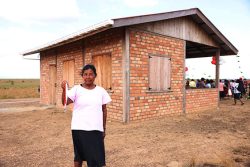(Trinidad Guardian) There are over 200 confirmed cases of the Zika virus in T&T.
Of this number, 60 have been diagnosed in women who are pregnant.
Contacted yesterday, Health Minister Terrence Deyalsingh said 59 cases had been recorded in Trinidad, and one in Tobago.
In seeking to reassure the infected people that every possible measure was in place to ensure they received the necessary treatment, Deyalsingh has maintained his confidence in the specialist team assembled by the Ministry of Health to oversee the diagnosis and treatment of pregnant people.
Asked to explain the disparity in the figures as last Friday he said he was aware there were only two Zika cases in pregnant women locally, Deyalsingh said he only received the official statistics early yesterday.
Pressed to say if the ultrasounds had revealed any of the foetuses contracting microcephaly as a result of the mother being diagnosed with Zika, Deyalsingh said, “So far, there is no risk of microcephaly in any of the cases we have seen.”
This was later confirmed by Dr Karen Sohan, Medical Chief of Staff, Mt Hope Women’s Hospital.
Microcephaly is a medical condition where babies’ heads are abnormally small.
Adopting a proactive stance in April, the specialist committee which is led by Sohan was set up to develop specific processes and procedures to respond to the diagnosis of the Zika virus in patients, with special attention being paid to pregnant women and developing foetuses.
The committee is set to meet later this week to discuss how they can strengthen operating procedures.
Urging citizens to continue to ensure their surroundings are free of any items that could act as a possible breeding site since the virus was spread by the Aedes Aegypti mosquito, both Deyalsingh and Sohan agreed that the public’s response had been positive and had helped in keeping the number of cases down.
The risk of more breeding sites increased with the rainy season at the beginning of June.
However, Deyalsingh said, “While it has been a good thing, the public needs to keep up the pressure.”
He said the ministry would also continue its attack on various fronts including concentrated efforts by the Insect Vector Control Division to spray schools, homes and government buildings.
Owners of vacant and abandoned lots have been asked to make an attempt to clean the premises also.
Zika symptoms include a rash, fever, generalized pains and conjunctivitis.
Responding to questions yesterday, Sohan endorsed the ministry’s policy outlining the treatment of pregnant women as she explained, “There is a national policy whereby any woman who tests positive for Zika is referred for Foetal Medicine Services at the Mt Hope Women’s Hospital.”
Adding that it involved patient counseling as well as detailed ultrasounds of the baby, Sohan said, “This has been operational since the first case was diagnosed. Zika is a new pathology and therefore as the numbers increase we would need to fine tune the service.”
Revealing that only one baby had so far been delivered of a mother who had been diagnosed with Zika, Sohan said, “That baby is normal so far.”
She went on to confirm, “To date, no babies have been born with microcephaly secondary to Zika.”
Sohan added, “The most vulnerable time for the pregnant patient appears to be the period while the brain is developing. The functioning cells of the brain are the neurons and these appear to be most vulnerable less than ten weeks gestation. There still appears to be a risk to the foetal brain although reduced, from 10 to 16 weeks. The virus has been shown to affect the growth of the baby up to 28 weeks gestation.”
Stressing that new information was emerging daily about infection rates and vulnerable populations, Sohan said it was equally as important for all healthcare providers and patients to be updated.
She said, “When the patient is seen, her care is individualised depending on the period of gestation. Some patients will require only one scan whereas others require more frequent scans. At each visit, the ultrasound findings are discussed with the patient as well as a plan of management for the pregnancy. This information, including the detection of abnormalities is confidential, and involves the patient and her healthcare providers.”
Sohan said while she was aware that there was also a policy for management of the babies following delivery, she was unable to comment as this was not her area of expertise.






